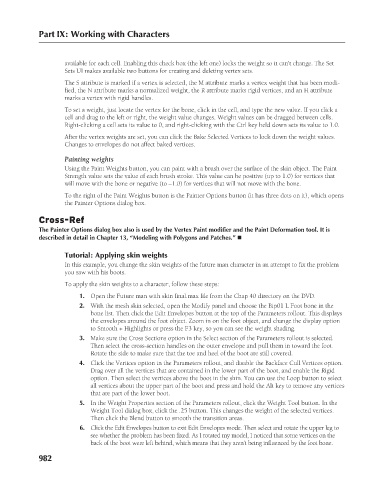Page 1030 - Kitab3DsMax
P. 1030
Part IX: Working with Characters
available for each cell. Enabling this check box (the left one) locks the weight so it can’t change. The Set
Sets UI makes available two buttons for creating and deleting vertex sets.
The S attribute is marked if a vertex is selected, the M attribute marks a vertex weight that has been modi-
fied, the N attribute marks a normalized weight, the R attribute marks rigid vertices, and an H attribute
marks a vertex with rigid handles.
To set a weight, just locate the vertex for the bone, click in the cell, and type the new value. If you click a
cell and drag to the left or right, the weight value changes. Weight values can be dragged between cells.
Right-clicking a cell sets its value to 0, and right-clicking with the Ctrl key held down sets its value to 1.0.
After the vertex weights are set, you can click the Bake Selected Vertices to lock down the weight values.
Changes to envelopes do not affect baked vertices.
Painting weights
Using the Paint Weights button, you can paint with a brush over the surface of the skin object. The Paint
Strength value sets the value of each brush stroke. This value can be positive (up to 1.0) for vertices that
will move with the bone or negative (to –1.0) for vertices that will not move with the bone.
To the right of the Paint Weights button is the Painter Options button (it has three dots on it), which opens
the Painter Options dialog box.
Cross-Ref
The Painter Options dialog box also is used by the Vertex Paint modifier and the Paint Deformation tool. It is
described in detail in Chapter 13, “Modeling with Polygons and Patches.” n
Tutorial: Applying skin weights
In this example, you change the skin weights of the future man character in an attempt to fix the problem
you saw with his boots.
To apply the skin weights to a character, follow these steps:
1. Open the Future man with skin final.max file from the Chap 40 directory on the DVD.
2. With the mesh skin selected, open the Modify panel and choose the Bip01 L Foot bone in the
bone list. Then click the Edit Envelopes button at the top of the Parameters rollout. This displays
the envelopes around the foot object. Zoom in on the foot object, and change the display option
to Smooth + Highlights or press the F3 key, so you can see the weight shading.
3. Make sure the Cross Sections option in the Select section of the Parameters rollout is selected.
Then select the cross-section handles on the outer envelope and pull them in toward the foot.
Rotate the side to make sure that the toe and heel of the boot are still covered.
4. Click the Vertices option in the Parameters rollout, and disable the Backface Cull Vertices option.
Drag over all the vertices that are contained in the lower part of the boot, and enable the Rigid
option. Then select the vertices above the boot in the shin. You can use the Loop button to select
all vertices about the upper part of the boot and press and hold the Alt key to remove any vertices
that are part of the lower boot.
5. In the Weight Properties section of the Parameters rollout, click the Weight Tool button. In the
Weight Tool dialog box, click the .25 button. This changes the weight of the selected vertices.
Then click the Blend button to smooth the transition areas.
6. Click the Edit Envelopes button to exit Edit Envelopes mode. Then select and rotate the upper leg to
see whether the problem has been fixed. As I rotated my model, I noticed that some vertices on the
back of the boot were left behind, which means that they aren’t being influenced by the foot bone.
982

